With the exception of Antarctica, lizards are a vast and varied group of reptiles that are found on every continent. With a maximum length of three meters, monitor lizards are the biggest species of lizards! And the tiniest, geckos, may grow to a size of only 2 cm.
Lizards are protected like they are made of armour by their strong scales. These aid in water retention and act as a barrier against predators. These rough, parched scales may be challenging to break through and resemble an unpleasant supper. Which creatures, therefore, would attack and consume a lizard? Would anything be brave enough to challenge these reptiles?
The short answer to this is that a lot of creatures will definitely eat a lizard! A supper consisting of lizards will be happily consumed by some species of birds, fish, cats, carnivorous animals, snakes, and alligators. The size and location of the lizard prey determine the kind of predator.
The primary animal groups that will consume lizards in the wild will be discussed below, along with the means and motivations behind their actions. Come investigate an interesting topic with us.
A Short List of Animals That Consume Lizards
birds such as roadrunners, corvids, blue jays, sparrows, owls, hawks, and eagles
snakes, crocodiles, alligators, and various lizards are examples of reptiles.
Canids such as foxes, wolves, coyotes, dingoes, wild dogs, and jackals
Additional carnivorous mammals include rats, possums, raccoons, cats, mongooses, weasels, lynxes, and bats.
Spiders
Quite a lengthy list! In most of the habitats they live in, lizards are toward the bottom of the food chain (with the exception of huge, carnivorous species like monitor lizards and Komodo dragons). As long as they can match the speed and agility of the majority of lizard species, this makes them a viable alternative for many predators! If not, they have to surprise the lizard.
It will be worthwhile to learn about the defensive strategies lizards use to fend off predators before examining these typical types of lizard predators in more detail.
How Do Lizards Protect Theirselves Against Hunters?
Apart from their hard keratin-based scales, several lizard species have an amazing array of defensive mechanisms against potential predators. Among these are a few of these:
Lizards possess a remarkable capacity to simply shed their tails in response to attacks or threats from predators. A few minutes later, the tail will break off and start to squirm about! This works as a good diversion, allowing the lizard to get away while the predator is preoccupied with its tail. After some time, lizards may regenerate their tail. Fantastic!
Changing colors and camouflage: A lot of lizards have coloring that successfully melds in with their natural surroundings. Some animals, such as chameleons, are even capable of changing the color of their skin! Generally speaking, this is seen as a communication tactic rather than something done for aesthetic purposes. However, glaring warning colors in this manner might deter or frighten a possible predator.
Hissing: When a predator is pursuing a lizard, some of them will hiss loudly. A predator may get alarmed enough by this to flee immediately.
Blood-squirting: To protect themselves against an invading predator, horned lizards use an amazing defense mechanism known as reflex bleeding, also known as autohaemorrhaging. They are able to shoot blood directly into the predator’s face via their eyes! If blood gets in the predator’s mouth or eyes, it scares or even repels it. The horned lizard will descend from it and quickly try to get free. (Watch some amazing video here!)
We’ll now take a closer look at each category of creatures that may be categorized as lizard predators.
Which creatures Eat lizards?
Do Birds Eat lizards?

One of the most frequent predators of lizards worldwide, a great number of birds will often hunt them down for food. Birds can see lizards from a great distance and have an aerial edge over them. Lizards are ectotherms, meaning they must heat their cold blood in the sunshine by basking in open areas. Because birds have such keen vision, they can pick up even the smallest trace of movement, rendering lizards’ ability to conceal themselves meaningless.
Predators that hunt prey, such raptors, eagles, and hawks, have great success killing lizards. Some use the tactic of hovering above an obliging lizard, waiting for the right opportunity to attack and drag it away. The Red-tailed hawk is a frequent predator of small to medium-sized lizards in North America. Although owls prey on lizards, most owl species are nocturnal, meaning they are active at night, and they do not often come across diurnal, or daytime, lizards.
For smaller lizards, opportunistic birds such as roadrunners, corvids, and blue jays pose a threat. They have the cunning to sneak up on a lizard snack, even though they usually choose simpler things like fruits, seeds, and carrion. Smaller lizard species, such as geckos, are also preyed upon by little birds like sparrows. Larger water birds, such as the Great egret, may also often forage along the coastline in search of lizards.
Chickens and other domestic birds are ravenous omnivores. Chickens would absolutely hunt and devour smaller lizards if given the chance.
Do Other Reptiles Eat Lizards?

Lizards are often preyed upon by snakes, particularly the bigger ones. By applying constriction or injecting venom via their lethal bites, they may subdue and devour lizards. It can also happen the other way around, with lizards predating snakes in situations when they are much bigger than the latter. Lizards make up almost all of Elapid snakes’ food. A gecko is being consumed by an Oriental tree snake in the picture below.
As vicious predators, crocodiles and alligators both place lizards firmly on their diets. While crocodiles in certain regions of North America struggle with monitor lizards, alligators in other locations specialize in consuming water monitors. These cunning reptiles often hunt for crocodile eggs, and they’ll try to dash in and out of their burrows to grab their juicy treats. Although crocodiles would try to capture and devour a monitor lizard, it is uncommon for them to get the opportunity since these reptiles are adept at moving quickly.
Indeed! Lizards that are carnivores will consume smaller lizards. Certain species may even exhibit cannibalistic behavior; large Komodo dragon adults, for instance, have been known to turn on and devour young ones. When they are mature enough, the juveniles will hide in trees to protect themselves from adult predators, who are mostly ground-based.
Many animals in the vast and varied family Canidae would consume lizards if they thought the effort was worthwhile. Lizards are reported to be eaten by wolves, dingoes, wild dogs, coyotes, jackals, and foxes. In certain parts of North America, coyotes in particular may be a serious danger to some species of lizards. Dogs kept as pets have sometimes caught and eaten lizards, however this is not very common. But because many canids are nocturnal, they won’t often come across lizards during the day.
Which Other Mammals Consume Lizards?
As ferocious predators, mongooses are renowned for bringing down bigger prey and confronting potentially hazardous species such as snakes. They could choose lizards as one of their simpler meals because of their bravery when it comes to chasing live food. Comparably, despite their tiny stature, weasels are fierce predators that will kill and consume any smaller lizards they come across.
Possums, rats, and raccoons are examples of opportunistic omnivores that have evolved for a varied diet. They will scavenge almost everything that comes in their path, including a passing lizard.
It may surprise you to learn that several bat species have evolved to become lizard eaters. Although the majority of bats are specialized in consuming fruit or insects, certain carnivorous species may seek out and devour lizards if they happen to be around. Rather of diving to the ground, where they would become prey for ground predators, bats typically pick them from trees.
Like their wild counterparts, domestic cats sometimes capture and consume lizards. Lizards are also preyed upon by larger, wild cats such as leopards and lynx. They can easily outrun swift lizards thanks to their agility and quickness.
Is Lizard Eating by Spiders?

It’s amazing that certain spider species would feed on lizards. Larger spider species often target smaller lizard species. The Regal jumping spider’s ability to effectively attack and consume lizards up to three times their size is possibly its most fascinating trait! They will grasp a struggling lizard with spine-like features on its front legs, bite it, and inject venom into it. An amazing illustration of a very specialized lizard-eating adaption!
Do Humans Eat Lizards?
There are various places and civilizations that eat lizards, even if it’s not a very widespread practice when it comes to consuming meat worldwide. The majority of lizards are safe for humans to eat, although eating them may provide challenges with regard to cleanliness and proper preparation. They often contain harmful pathogens like E. Coli and Salmonella. Although they are typically slender and do not produce much meat for humans, lizards do contain essential minerals. People often kill and consume iguanas in locations where they are prevalent. For instance, in 2014, severe droughts caused significant food shortages in Nicaragua. Iguanas were an essential food source during this time.
FAQs
What creatures consume the eggs of lizards?
In addition, almost all of the animals on our list today consume lizard eggs, which are a good source of protein. Carnivorous insects will also aggressively seek for and consume lizard eggs. In some parts of the globe, people eat lizard eggs as a delicacy.
What creatures consume deceased lizards?
Too many to list! Any scavenging creature that consumes carrion will consume a lizard’s corpse without discrimination. The chance to feed on and decompose a lizard body will be seized by significant decomposing species like beetles, which provide an essential function by recycling nutrients back into the environment.






